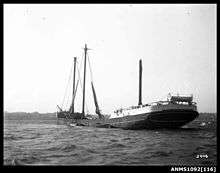Inca (schooner)
 Damaged schooner INCA at anchor, possibly in Sydney Harbour, c 1920. | |
| History | |
|---|---|
| Builder: | Hall Brothers, Port Blakely, WA |
| Launched: | 1896[1] |
| Struck: | 1920 |
| General characteristics | |
| Tonnage: | 901.88 tons |
| Length: | 215 ft. 5 in. |
| Beam: | 41 ft. 3 in. |
| Draft: | 16 ft. 5 in. |
| Sail plan: | 5-masted schooner[2] |
The Inca was "the first true five-masted schooner built on the West Coast."[3]
Inca, "the second of her rig built on the Pacific, was launched at Port Blakely by Hall Bros. in 1896."[4]
Launching
"The Inca, because of its size and rig, had attracted considerable attention during the progress of its construction and when the time set for launching arrived a large crowd of people was present in the shipyards. The Port Blakeley schools were closed so that the pupils might attend the exercises incident to launching. Little Miss Melusina Thornton, the nine-year-old daughter of Chief Engineer Thornton of the steamer Sarah Renton, christened the new boat as it slipped into the water a few minutes before 11 o'clock on the morning of November 11, 1896."[5]
First cargo of sugar to Port Costa refinery
On April 3, 1898, the Inca brougnt the first cargo, 31,763 bags of sugar, from Honolulu to the new sugar refinery at Port Costa, California. The barkentine Planter followed with a second sugar cargo from Honolulu shortly thereafter.[6]
Voyage to Alaska gold fields, 1902
On May 13, 1902, Inca was the first vessel to leave Newcastle, Australia for Nome, Alaska, bound for the gold fields.[7]
Lumber schooner
Inca was active in the West Coast lumber trade. In 1907, she arrived in San Francisco with over a million board feet of lumber on board—1,100,000 board feet, according to a local report.[8] Two examples of her lumber voyages follow:
Inca arrived in Astoria, Oregon from Honolulu on July 19, 1910, after discharging ballast at Linnton. She was scheduled to load lumber at the Inman Paulsen mills for New Zealand.[9]
According to Gordon R. Newell, Inca "left Eureka, California October 10, 1920, with a cargo of redwood lumber for Sydney, Australia and was dismasted in the South Pacific. She was abandoned on December 7 by all hands except two men who volunteered to remain on board. The captain, his wife and the other 10 men of the crew set out in the boats and were sighted by the steamship Cosmos, which towed the Inca to Sydney, where she arrived December 18, discharged her cargo and was subsequently hulked." [10]
Schooner Inca in popular culture
"Inca Lane" in San Francisco is supposedly named after the 5-masted schooner.[11]
See also
- West coast lumber trade
- Port Blakely, WA
- Eureka, California, section Lumber and developing economy
References
- ↑ Newell, Gordon R. (1966). "Maritime Events of 1896", H.W. McCurdy Marine History of the Pacific Northwest. Seattle: Superior Publishing Co. p. 4. Retrieved 2010-02-27.
- ↑ Governor Ames and the Inca, the only five-masted topsail schooners in the world, San Francisco Call, Volume 83, Number 126, 5 April 1898
- ↑ Bruzelius, Lars (Oct 6, 1996). "Sailing Ships: Five-masted schooners". Retrieved 2010-02-27.
- ↑ Lyman, John (May 10, 1941). "Pacific coast built sailers 1850-1905". The Marine Digest. p. 2. Retrieved 2010-02-27.
- ↑ Begley, Clarence (1916). History of Seattle from the earliest settlement to the present time. Chicago: S.J Clarke Publishing Co. pp. 615–616.
- ↑ Alaska Fever Now Abating. San Francisco Call, Volume 83, Number 125, 4 April 1898
- ↑ San Francisco Call, Volume 93, Number 165, 14 May 1903 — From Australia to Nome
- ↑ Shipping News and Gossip of the Water Front, San Francisco Call, Volume 102, Number 16, 16 June 1907
- ↑ Shipping News of Coast, San Francisco Call, Volume 108, Number 50, 20 July 1910
- ↑ Newell, Gordon R. (1966). "Maritime Events of 1919-1920", H.W. McCurdy Marine History of the Pacific Northwest. Seattle: Superior Publishing Co. p. 312. Retrieved 2010-02-27.
- ↑ Donat, Hank (2008). "Mr. SF.com, Streets of the City". Retrieved 2010-02-27.
External links
- Governor Ames and the Inca, the only five-masted topsail schooners in the world, San Francisco Call, Volume 83, Number 126, 5 April 1898
Further reading
- Gibbs, Jim (1966). West Coast Windjammers in Story and Pictures (1st ed.). Seattle: Superior Publishing Co.—Three photos of Inca, including the frontispiece